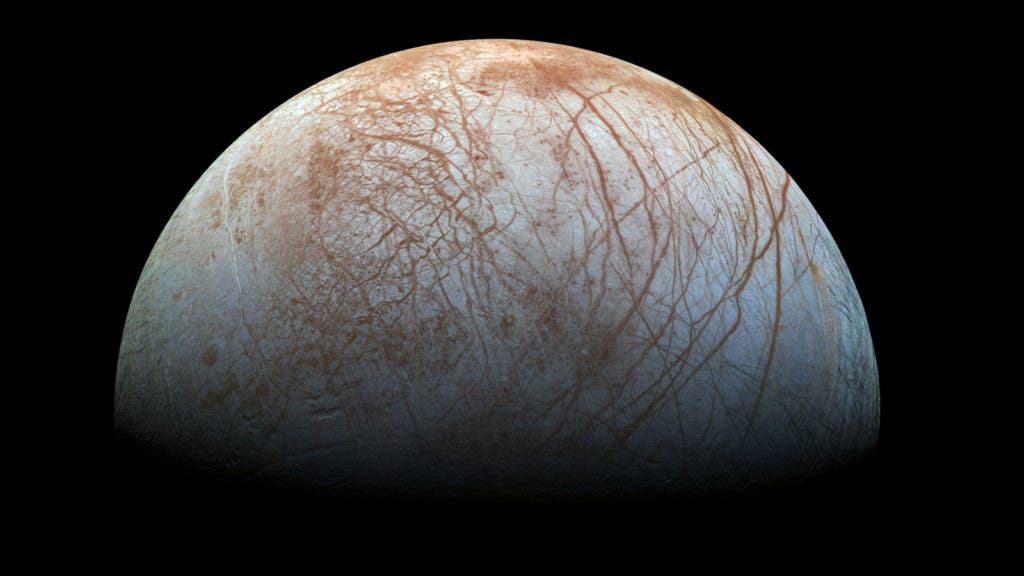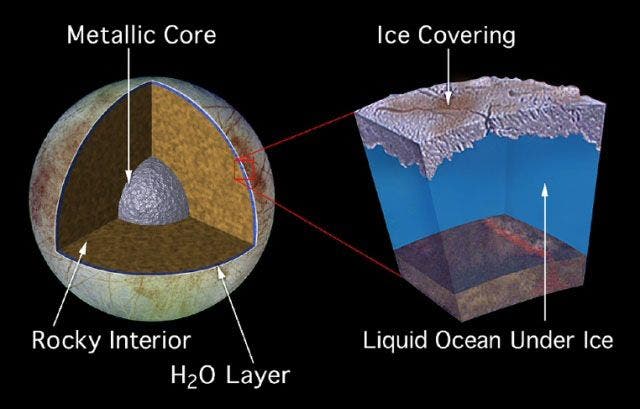NASA has confirmed that Jupiter’s moon Europa contains liquid water, making it one of the most promising places we know for extraterrestrial life.

At first glance, not much is happening on Europa. A small, frozen world orbiting Jupiter doesn’t seem like the most interesting place out there. But 40 years ago, the Voyager snapped an intriguing photo of the satellite: its frozen surface wasn’t stale and monotonous, it was cracked and sliced by different features, suggesting active and recent phenomena. Subsequent missions showed even more exciting things.
Despite being undoubtedly bombarded by meteorites, Europa’s surface is largely devoid of craters. This means that something must have erased or eroded them, suggesting some active geology. Not only is Europa active — it has some form of tectonics, and more impressively, it seems to have liquid water. The liquid water isn’t on the surface but rather beneath the frozen surface. The pattern of the cracks observed on Europa’s surface suggest that the frozen surface of the planet is not locked to the rest of the interior, which is exactly what you’d expect to happen if a layer of liquid were to exist beneath the surface.
To make things even more tantalizing, astronomers have observed something which seems to be plumes of water emerging from Europa. Some of the plumes are hundreds of kilometers high, adding even more evidence to the case for water on Europa.
Now, that case is essentially proven. Researchers looking from the W. M. Keck Observatory, atop the dormant Mauna Kea volcano in Hawaii, found a clear signature of water molecules.
“Essential chemical elements (carbon, hydrogen, oxygen, nitrogen, phosphorus, and sulfur) and sources of energy, two of three requirements for life, are found all over the solar system. But the third — liquid water — is somewhat hard to find beyond Earth,” said Lucas Paganini, a NASA planetary scientist who led the water detection investigation. “While scientists have not yet detected liquid water directly, we’ve found the next best thing: water in vapor form.”

Detecting the signatures of elements on other planets is much more difficult than on Earth. Naturally, Europa’s environment is very different from that of Earth. The main idea behind the study was to use a spectrograph to assess the chemical composition of Europa by measuring how molecules on the satellite interact with infrared light. Molecules such as water emit specific frequencies which can be used as signatures.
But when your telescope is based on Earth, all light would pass through the Earth’s atmosphere — which contains a lot of water on its own. Paganini’s team had to use complex modeling to simulate the conditions of Earth’s atmosphere and then subtract them from what they were seeing on Europa. It wasn’t an easy task, but in the end, the researchers were successful.
Even so, they say, they’d like to get much closer to Europa to see what’s going on.
“We performed diligent safety checks to remove possible contaminants in ground-based observations,” said Avi Mandell, a Goddard planetary scientist on Paganini’s team. “But, eventually, we’ll have to get closer to Europa to see what’s really going on.”
They’ll get their wish fairly soon. NASA’s Clipper mission is set to launch in 2025, with the objective of analyzing Europa’s habitability and chemistry, as well as its geology. The mission will also aid in the selection of a landing site for the future Europa Lander, which, as the name implies, is scheduled to land on Europa to analyze it in unprecedented detail. Even before that, the ESA’s JUpiter ICy moons Explorer (JUICE) is set to launch in 2022, with the purpose of analyzing Jupiter’s Galilean moons: Ganymede, Callisto, and Europa.
For a period, the two spacecraft will both be orbiting Europa, enabling us to understand the satellite better than ever before. Hopefully, these missions could help answer one of the most tormenting questions in modern astronomy.
Europa, this small frozen rock orbiting Jupiter, has water. Could it have life?










